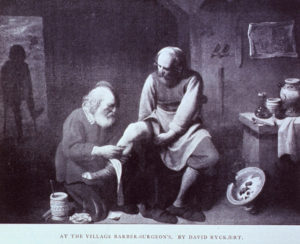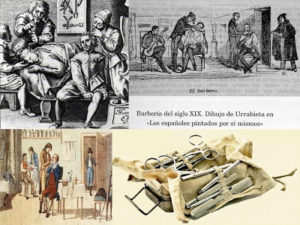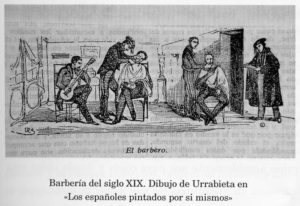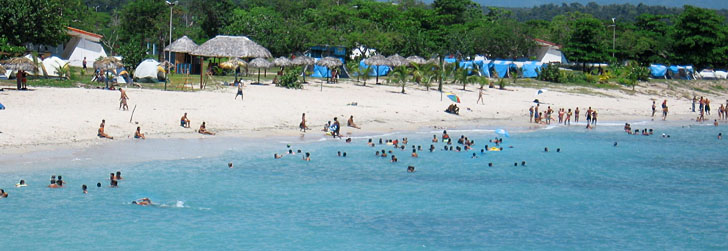It should be remembered that in the Middle Ages, barbers were not only engaged in the cutting of hair or shaving of man, but, based on the decisions of the authorities of the Catholic Church that forbade clerics to perform surgery, began to be made by the barbers.
In spite of its thirteen thousand inhabitants by the middle of 1550, Havana had no doctor. In the rest of the country of course not either.
In 1515 there were only “wound healers” in Cuba, as Fernandez Castillo points out in his Mexican Medical Chronology (Mexico Medical Gazette, December 31, 1945) that in the expedition of Cortes for the conquest of Mexico in 1519 there were ignorant soldiers that made of surgeons like Juan “Catalan” that “sanctified and embalmed wounds and unbalances”; Murcia, “barber and apothecary”; and Bottle “necromancer and astrologer”, who healed wounds with dirty rags. And that with the expeditionaries of Narvaez “was the master Juan de Amezquita, surgeon who healed some bad wounds and was equal in cures.”
In 1538 a law was promulgated in Spain so that “no person, even a graduate, can practice in the Indies as a doctor and surgeon without a license from the Council of Spain.” This complicated situation brought about by their precariousness, irregularities in the admission of surgeons, apothecaries, bone composers, phlebotomists or bleeders and others who lacked accreditation and falsified their titles, but before them the Cabildo was shown condescending given the poor situation of the public health. So they turned a blind eye when people went to healers or herbalists, especially in the rest of the country.
As a solution to this situation, an act of the Cabildo dated August 26, 1552 states: “Juan Gómez’s reception. On this day his favors from the said Governor Juscias e Regidores received by barber and surgeon from this Villa Juan Gómez shelf in she who is a teacher examined in the said office and skillful enough to use and exercise: and we sent and sent by another person none during the time that the said Juan Gómez lived in this said village using the said office be daring to use the said office under penalty of two pesos of gold for each time they use the said office which apply to the said Juan Gómez barber. ” Signed Dr. Angel Juan Rojas-Diogo de Soto-Antonio de Soto-Antonio de la Torre. The Lcdo. Avendaño-Pedro Blasco and Juan de Lobera. ”
That is to say, that when Havana still had no strength, not even the Morro, a very important event occurred in the life of its neighbors: the first barber was received in the city.
On July 1, 1552, the barber, whose name was Juan Gomez, came to give a solution not only to cutting hair, but to the work for which he was most sought, as a surgeon, because people could have hair long, but not with an open sword wound or a harquebus shot into the ribs.
The arrival of Juan Gomez was so desired that the Cabildo held a party with a serenade and everything, where they played the only three musicians that Havana had, one of which was timbalero. It seems that the barber was very good, because the neighbors, constituted with the Cabildo, seven months later, agreed: “Whoever breached the regulations could be punished with two pesos fine gold.
To guarantee that there was no unnecessary friction, the Cabildo granted the licenciado Gamarra monopoly of the pharmacy trade and by law the neighbors could not be cured with another person. “This eliminated the competition between Gomez and Gamarra. The first would be dedicated to the practice of surgery and the second to something similar to what we now call general medicine.
As there were no other doctors in Havana, a plague of healers and sorcerers cured the population with practices that were considered barbaric and heresy.
But the arrival of Juan Gómez was the beginning of a practice that centuries later would be an activity that would emphasize Cuban medicine internationally, and despite having not had the technological advances worldwide, is recognized for its quality.
RECUERDOS DE LA VIEJA CIUDAD DE LA HABANA: EL PRIMER BARBERO.
Hay que recordar que en la Edad Media, los barberos no se dedicaban exclusivamente al corte de pelos o afeitado del hombre, sino que, a partir de las decisiones de las autoridades de la Iglesia Católica que prohíbieron que los clérigos realizaran operaciones de cirugía, estas comenzaron a ser hechas por los barberos.
Pese a sus trece mil habitantes hacia mediados de 1550, La Habana no contaba con ningún médico. En el resto del país por supuesto que tampoco.
En 1515 sólo había en Cuba “curadores de heridas” pues señala Fernández Castillo, en su Cronología Médica Mexicana (Gaceta Médica de México, de 31 de Diciembre de 1945) que en la expedición de Cortés para la conquista de México en 1519 iban soldados ignorantes que hacían de cirujanos como Juan “Catalán” que “santiguagua y embalsamaba heridas y descalabraduras”; Murcia, “barbero y boticario”; y Botella” nigromántico y astrólogo”, que curaban las heridas con trapos sucios. Y que con los expedicionarios de Narváez “iba el maestro Juan de Amezquita, cirujano que curaba algunas malas heridas y se igualaba en las curas”.
En 1538 se promulgó en España una ley para que “ninguna persona aunque sea graduada pueda ejercer en las Indias de médico y cirujano sin que lleve licencia del Consejo de España”. Esta complicada situación trajo consigo por su precariedad, irregularidades en la admisión de cirujanos, boticarios, componedores de huesos, flebotomianos o sangradores y otros que carecían de acreditación y falsificaban sus títulos, pero ante ellos el Cabildo se mostraba condescendiente dada la mala situación de la salud pública. Por ello se hacían de la vista gorda cuando la gente iba a curanderos o herbolarios, sobre todo en el resto del país.
Como solución a esta situación, en un acta del Cabildo de fecha 26 de agosto de 1552 se dice: “Recibimiento de Juan Gómez. Este día sus mercedes del dicho señor Gobernador Justicias e Regidores recibieron por barbero e cirujano desta Villa a Juan Gómez estante en ella el cual es maestro examinado en el dicho oficio e hábil e suficientemente para usar y exercer : e mandamos y mandaron por otra persona ninguna durante el tiempo que el dicho Juan Gómez viviese en esta dicha villa usando el dicho oficiono sea osado a usar del dicho oficio so pena de dos pesos de oro por cada vez que usaren del dicho oficio los cuales aplican para el dicho Juan Gómez barbero”. Firman el Dr. Ángel Juan Rojas-Diogo de Soto-Antonio de Soto-Antonio de la Torre. El Lcdo. Avendaño-Pedro Blasco y Juan de Lobera.”
Es decir, que cuando La Habana todavía no tenía ninguna fortaleza, ni siquiera el Morro, ocurrió un acontecimiento muy importante en la vida de sus vecinos: se recibió en la ciudad al primer barbero.
El 1ro de julio de 1552 llegó el barbero, que se llamaba Juan Gómez, el que iba a dar solución no solo a cortar el pelo, sino a la labor para la que era más reclamado, como cirujano, porque la gente podía tener el cabello largo, pero no con una herida de espada abierta o una bala de arcabuz incrustada en las costillas.
Fue tan deseada la llegada de Juan Gómez que el Cabildo le celebró una fiesta con serenata y todo, donde tocaron los únicos tres músicos con que contaba La Habana, uno de los cuales era timbalero. Parece que el barbero era muy bueno, porque los vecinos, constituidos con el Cabildo, siete meses después, acordaron: “Aquel que incumpliera con la reglamentación podía ser castigado con dos pesos oro de multa.
Para garantizar que no hubiese roces innecesarios el Cabildo le otorgó al licenciado Gamarra el monopolio del comercio de botica y por ley los vecinos no se podían curar con otra persona.” De esa forma se eliminaba la competencia entre Gómez y Gamarra. El primero se dedicaría a la práctica de la cirugía y el segundo a algo semejante a lo que llamamos hoy medicina general.
Al no existir otros médicos en La Habana, una plaga de curanderos y brujos curaban a la población con prácticas que se consideraban bárbaras y herejías.
Pero la llegada de Juan Gómez fue el comienzo de una práctica que siglos más tarde sería una actividad que destacaría a la medicina cubana internacionalmente, y que a pesar de que no ha contado con los adelantos tecnológicos mundiales, es reconocida por su calidad.
Agencies/MemoriasCubanas/Carlos Rodríguez/Internet Photos/ Arnoldo Varona/ TheCubanHistory.com
THE CUBAN HISTORY, HOLLYWOOD.










